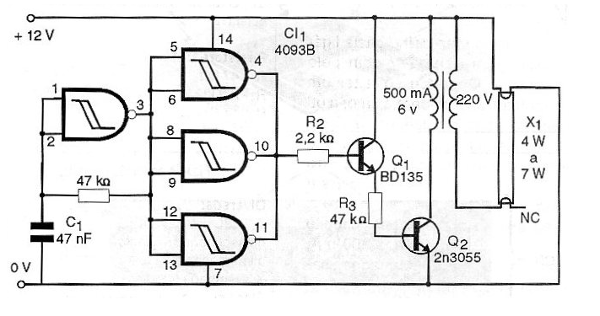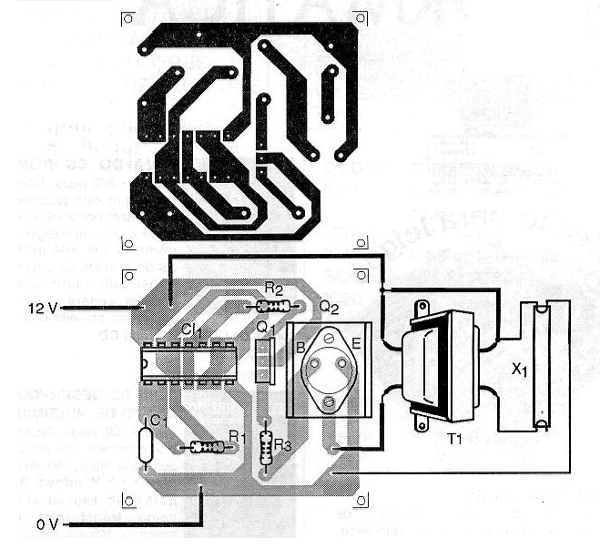An inverter is nothing more than a power stage oscillator that feeds a transformer in order to generate high voltage to excite a fluorescent lamp.
As this type of circuit does not generate a sine wave and its frequency is not 60 Hz or 50 Hz, it usually does not lend itself to powering more critical electronic circuits or devices that have motors like razors. However, it serves perfectly to power fluorescent lamps.
Another possible application for this circuit is as fence electrificator since the high voltage generated in the transformer produces a good shock.
HOW IT WORKS
The low frequency oscillator basically consists of an integrated circuit port 4093B used as an inverter. The frequency of this circuit is determined by R1 and C1. Depending on the characteristics of the transformer it may be interesting to change R1 in order to obtain the frequency that provides the highest efficiency.
The signal from this oscillator is rectangular and is applied to the three other ports of the same integrated circuit which then functions as a digital amplifier. The signal obtained is still weak to excite a transformer so that it passes through two stages of amplification formed by the transistors Q1 and Q2. These transistors are directly coupled for greater efficiency and simplicity of the circuit.
The signal amplified by the second transistor is strong enough to excite a transformer thus generating the high voltage needed by the ionization of the fluorescent lamp. The used transformer can be of any type with a 220 V and 6 to 12 volt secondary with current in the range of 500 mA to 1 A.
The ideal fluorescent lamp for this application is a miniature 4 to 7 watt type when higher performance is obtained. However larger bulbs, in the range of 15 to 40 watt can be used with lower yield.
Even lamps that no longer light up normally in the power grid because they are very weak will normally work in this circuit because the generated high voltage peaks are intense enough to cause the ionization of the gas inside. Note also that with this type of circuit it is not necessary to use neither a reactor nor a starter.
ASSEMBLY
In figure 1 we have the complete diagram of the inverter.

In figure 2 we have the arrangement of the components on a printed circuit board.

Note that the power transistor Q2 must be mounted on a good heat radiator. For added safety, the integrated circuit can also be mounted in a socket. The other components are all common, only observing that the resistor R3 must be at least 1 watt.
The apparatus may be housed in a metal or plastic housing but the wires to the fluorescent lamp should be well insulated to avoid strong shocks due to the high voltage present.
TEST AND USE
To test the device simply connect it to a 12V source with at least 2A. then just make a connector suitable for the battery or the location of the car cigarette lighter. The inverter wires to the battery must be thick and not too long so that no losses occur. The current drained by the circuit is in the range of 400 to 800 mA depending on the transformer used.
An interesting application for this circuit is the use of an ultraviolet fluorescent lamp (of the type used in dances) that is used to verify the fluorescence of rocks in mineral researches.
Semiconductors:
CI-1 - 4093B - CMOS integrated circuit
Q1 - BD135 - medium power NPN transistor
Q2 - 2N3055 - High Power NPN Transistor
Resistors: (1/8W, 5%)
R1 - 47 k ohm
R2 - 2.2 k ohm
R3 - 47 ohm / 1W
Capacitors:
C1 - 47 nF - polyester or ceramic
Several:
T1 - 220V of primary and 6V x 500 mA of secondary - power transformer - see text
X1 - 4 to 7 watt fluorescent lamp
Printed circuit board, heat radiator for power transistor, wires, solder, etc.




